check engine YAMAHA XVS125 2002 Owners Manual
[x] Cancel search | Manufacturer: YAMAHA, Model Year: 2002, Model line: XVS125, Model: YAMAHA XVS125 2002Pages: 86, PDF Size: 1.63 MB
Page 6 of 86

EAU00009
TABLE OF CONTENTS
GIVE SAFETY THE RIGHT OF WAY ................1-1
DESCRIPTION ..................................................2-1
Left view ...........................................................2-1
Right view ........................................................2-2
Controls and instruments .................................2-3
INSTRUMENT AND CONTROL
FUNCTIONS ......................................................3-1
Main switch/steering lock .................................3-1
Indicator and warning lights .............................3-2
Speedometer unit ...........................................3-2
Anti-theft alarm (optional) ................................3-3
Handlebar switches .........................................3-3
Clutch lever ......................................................3-5
Shift pedal ........................................................3-5
Brake lever .......................................................3-5
Brake pedal ......................................................3-6
Fuel tank cap ...................................................3-6
Fuel ..................................................................3-7
Fuel cock .........................................................3-8
Starter (choke) lever ........................................3-9
Helmet holder ..................................................3-9
Adjusting the shock absorber assemblies .......3-9
Sidestand .......................................................3-10
Ignition circuit cut-off system ........................3-11PRE-OPERATION CHECKS .............................4-1
Pre-operation check list ...................................4-1
OPERATION AND IMPORTANT RIDING
POINTS ..............................................................5-1
Starting the engine ...........................................5-1
Starting a warm engine ....................................5-2
Shifting .............................................................5-3
Recommended shift points
(for Switzerland only) .....................................5-3
Tips for reducing fuel consumption .................5-4
Engine break-in ................................................5-4
Parking .............................................................5-5
PERIODIC MAINTENANCE AND
MINOR REPAIR .................................................6-1
Owner’s tool kit ................................................6-1
Periodic maintenance and lubrication chart .....6-2
Removing and installing panels .......................6-5
Checking the spark plugs ................................6-7
Engine oil and oil filter element .......................6-9
Cleaning the air filter element .......................6-12
Adjusting the carburetor .................................6-14
Adjusting the engine idling speed ..................6-14
Adjusting the throttle cable free play ..............6-15
Adjusting the valve clearance .......................6-15
123
456
5JX-28199-E2 honbun 10/11/01 2:14 PM Page 5
Page 13 of 86

3-2
EAU03034
Indicator and warning lights
Indicator lights
EAU00063
High beam indicator light “&”
High beam indicator light
This indicator light comes on when
the high beam of the headlight is
switched on.
EAU00057
Turn signal indicator light “5”
Turn signal indicator light
This indicator light flashes when the
turn signal switch is pushed to the left
or right.
EAU00061
Neutral indicator light “N”
Neutral indicator light
This indicator light comes on when
the transmission is in the neutral
position.
EAU04243
Engine trouble warning light “”
Engine trouble warning light
This warning light comes on or flash-
es when an electrical circuit monitor-
ing the engine is defective. When this
occurs, have a Yamaha dealer check
the self-diagnosis system.NOTE:
This warning light comes on for a few
seconds when the key is turned to
“ON”, but this does not indicate a
malfunction.
EAU01087
Speedometer unit The speedometer unit is equipped
with a speedometer, an odometer
and a tripmeter. The speedometer
shows riding speed. The odometer
shows the total distance traveled.
The tripmeter shows the distance
traveled since it was last set to zero
with the reset knob. The tripmeter
can be used to estimate the distance
that can be traveled with a full tank of
fuel. This information will enable you
to plan future fuel stops.
INSTRUMENT AND CONTROL FUNCTIONS
3
2040
600
km/h80
100
120140160
12 34
2040600
km/h80
100
120140160
1
23
4
1. High beam indicator light “&”
2. Turn signal indicator light “5”
3. Neutral indicator light “N”
4. Engine trouble warning light “”
1. Speedometer
2. Odometer
3. Tripmeter
4. Reset knob
5JX-28199-E2 honbun 10/11/01 2:14 PM Page 12
Page 22 of 86

3-11
INSTRUMENT AND CONTROL FUNCTIONS
3
EAU03720
Ignition circuit cut-off
system
Ignition circuit cut-off system
The ignition circuit cut-off system
(comprising the sidestand switch,
clutch switch and neutral switch) has
the following functions.
8It prevents starting when the
transmission is in gear and the
sidestand is up, but the clutch
lever is not pulled.
8It prevents starting when the
transmission is in gear and the
clutch lever is pulled, but the
sidestand is still down.
8It cuts the running engine when
the transmission is in gear and
the sidestand is moved down.
Periodically check the operation of
the ignition circuit cut-off system
according to the following procedure.
EW000045
wIf a malfunction is noted, have a
Yamaha dealer check the system
before riding.
5JX-28199-E2 honbun 10/11/01 2:14 PM Page 21
Page 23 of 86

3-12
INSTRUMENT AND CONTROL FUNCTIONS
3
With the engine turned off:
1. Move the sidestand down.
2. Make sure that the engine stop switch is set to “
#”.
3. Turn the key to “ON”.
4. Shift the transmission into the neutral position.
5. Push the start switch.
Does the engine start?
The neutral switch may be defective.
The motorcycle should not be ridden until
checked by a Yamaha dealer.
With the engine still running:
6. Move the sidestand up.
7. Keep the clutch lever pulled.
8. Shift the transmission into gear.
9. Move the sidestand down.
Does the engine stall?After the engine has stalled:
10. Move the sidestand up.
11. Keep the clutch lever pulled.
12. Push the start switch.
Does the engine start?
The sidestand switch may be defective.
The motorcycle should not be ridden until
checked by a Yamaha dealer.The clutch switch may be defective.
The motorcycle should not be ridden until
checked by a Yamaha dealer.
NO
NOTE:This check is most reliable if performed with
a warmed-up engine.
YESYES NO
The system is OK. The motorcycle can be ridden.
YES NO
5JX-28199-E2 honbun 10/11/01 2:14 PM Page 22
Page 24 of 86

4-1
EAU01114
PRE-OPERATION CHECKS
4 The condition of a vehicle is the owner’s responsibility. Vital components can start to deteriorate quickly and unexpect-
edly, even if the vehicle remains unused (for example, as a result of exposure to the elements). Any damage, fluid leak-
age or loss of tire air pressure could have serious consequences. Therefore, it is very important, in addition to a thor-
ough visual inspection, to check the following points before each ride.
EAU03439
Pre-operation check list
Pre-operation check list
ITEM CHECKS PAGE
Fuel•Check fuel level in fuel tank.
•Refuel if necessary.
•Check fuel line for leakage.3-6–3-7
Engine oil•Check oil level in engine.
•If necessary, add recommended oil to specified level.
•Check vehicle for oil leakage.6-9–6-12
Front brake•Check operation.
•If soft or spongy, have Yamaha dealer bleed hydraulic system.
•Check lever free play.
•Adjust if necessary.
•Check fluid level in reservoir.
•If necessary, add recommended brake fluid to specified level.
•Check hydraulic system for leakage.3-5, 6-20,
6-22–6-24
Rear brake•Check operation.
•Check pedal free play.
•Adjust if necessary.3-6, 6-20–6-23
Clutch•Check operation.
•Lubricate cable if necessary.
•Check lever free play.
•Adjust if necessary.3-5, 6-19
5JX-28199-E2 honbun 10/11/01 2:14 PM Page 23
Page 27 of 86

5-1
EAU00372
OPERATION AND IMPORTANT RIDING POINTS
5
EAU00373
w8Become thoroughly familiar
with all operating controls and
their functions before riding.
Consult a Yamaha dealer
regarding any control or func-
tion that you do not thorough-
ly understand.
8Never start the engine or oper-
ate it in a closed area for any
length of time. Exhaust fumes
are poisonous, and inhaling
them can cause loss of con-
sciousness and death within a
short time. Always make sure
that there is adequate ventila-
tion.
8Before starting out, make sure
that the sidestand is up. If the
sidestand is not raised com-
pletely, it could contact the
ground and distract the opera-
tor, resulting in a possible loss
of control.
EAU03515
Starting the engine
Starting the engine
In order for the ignition circuit cut-off
system to enable starting, one of the
following conditions must be met:
8The transmission is in the neutral
position.
8The transmission is in gear with
the clutch lever pulled and the
sidestand up.
EW000054
w8Before starting the engine,
check the function of the igni-
tion circuit cut-off system
according to the procedure
described on page 3-12.
8Never ride with the sidestand
down.
1. Turn the fuel cock lever to “ON”.
2. Turn the key to “ON” and make
sure that the engine stop switch
is set to “#”.
3. Shift the transmission into the
neutral position.NOTE:
When the transmission is in the neu-
tral position, the neutral indicator light
should be on, otherwise have a
Yamaha dealer check the electrical
circuit.
1
1. Arrow mark positioned over “ON”
5JX-28199-E2 honbun 10/11/01 2:14 PM Page 26
Page 30 of 86

5-4
OPERATION AND IMPORTANT RIDING POINTS
5
EAU00424
Tips for reducing fuel
consumption
Fuel consumption, tips for reducing
Fuel consumption depends largely on
your riding style. Consider the follow-
ing tips to reduce fuel consumption:
8Thoroughly warm up the engine.
8Turn the starter (choke) off as
soon as possible.
8Shift up swiftly, and avoid high
engine speeds during accelera-
tion.
8Do not rev the engine while shift-
ing down, and avoid high engine
speeds with no load on the
engine.
8Turn the engine off instead of let-
ting it idle for an extended length
of time (e.g., in traffic jams, at
traffic lights or at railroad cross-
ings).
EAU00436
Engine break-in
Engine break-in
There is never a more important peri-
od in the life of your engine than the
period between 0 and 1,000 km. For
this reason, you should read the fol-
lowing material carefully.
Since the engine is brand new, do
not put an excessive load on it for the
first 1,000 km. The various parts in
the engine wear and polish them-
selves to the correct operating clear-
ances. During this period, prolonged
full-throttle operation or any condition
that might result in engine overheat-
ing must be avoided.
EAU04399
0–500 km
Avoid prolonged operation above 1/3
throttle.
500–1,000 km
Avoid prolonged operation above 1/2
throttle.
ECA00058
cCAfter 1,000 km of operation, the
engine oil must be changed, and
the oil filter element replaced.1,000 km and beyond
The vehicle can now be operated
normally.
EC000049
cCIf any engine trouble should occur
during the engine break-in period,
immediately have a Yamaha dealer
check the vehicle.
5JX-28199-E2 honbun 10/11/01 2:14 PM Page 29
Page 35 of 86

6-4
PERIODIC MAINTENANCE AND MINOR REPAIR
6
EAU03541
NOTE:
8The air filter needs more frequent service if you are riding in unusually wet or dusty areas.
8Hydraulic brake service
9Regularly check and, if necessary, correct the brake fluid level.
9Every two years replace the internal components of the brake master cylinder and caliper, and change the brake
fluid.
9Replace the brake hoses every four years and if cracked or damaged.19
*Shock absorber
assemblies•Check operation and shock absorbers for oil leakage.√√√√
20*Carburetor•Check starter (choke) operation.
•Adjust engine idling speed.√√√√√ √
21 Engine oil•Change.
•Check oil level and vehicle for oil leakage.√√√√√ √
22 Engine oil filter element•Replace.√√√
23*Front and rear brake
switches•Check operation.√√√√√ √
24 Moving parts and cables•Lubricate.√√√√ √
25*Lights, signals and
switches•Check operation.
•Adjust headlight beam.√√√√√ √ NO. ITEM CHECK OR MAINTENANCE JOBODOMETER READING (× 1,000 km)
ANNUAL
CHECK
1 6 12 18 24
5JX-28199-E2 honbun 10/11/01 2:14 PM Page 34
Page 38 of 86

6-7
PERIODIC MAINTENANCE AND MINOR REPAIR
6 2. Pull the rear of the panel out with
the key inserted in the lock, and
then slide the panel forward to
release it in the front.To install the panel
1. Secure the front of the panel,
and then push the rear of the
panel in with the key inserted in
the lock.
2. Turn the key counterclockwise to
the original position, remove it,
and then close the lock cover.
EAU03329
Checking the spark plugs
Spark plugs, checking
The spark plugs are important engine
components, which are easy to
check. Since heat and deposits will
cause any spark plug to slowly erode,
the spark plugs should be removed
and checked in accordance with the
periodic maintenance and lubrication
chart. In addition, the condition of the
spark plugs can reveal the condition
of the engine.
To remove a spark plug
1. Remove the spark plug cap.
1
1. Spark plug cap
5JX-28199-E2 honbun 10/11/01 2:14 PM Page 37
Page 39 of 86

6-8
PERIODIC MAINTENANCE AND MINOR REPAIR
62. Remove the spark plug as
shown, with the spark plug
wrench included in the owner’s
tool kit.To check the spark plugs
1. Check that the porcelain insulator
around the center electrode on
each spark plug is a medium-to-
light tan (the ideal color when the
motorcycle is ridden normally).2. Check that all spark plugs
installed in the engine have the
same color.NOTE:
If any spark plug shows a distinctly
different color, the engine could be
defective. Do not attempt to diagnose
such problems yourself. Instead,
have a Yamaha dealer check the
motorcycle.3. Check each spark plug for elec-
trode erosion and excessive car-
bon or other deposits, and
replace it if necessary.To install a spark plug
1. Measure the spark plug gap with
a wire thickness gauge and, if
necessary, adjust the gap to
specification.
2. Clean the surface of the spark
plug gasket and its mating sur-
face, and then wipe off any grime
from the spark plug threads.
3. Install the spark plug with the
spark plug wrench, and then
tighten it to the specified torque.
1
a
1. Spark plug wrencha. Spark plug gap
Specified spark plug:
CR7HSA (NGK)
U22FSR-U (DENSO)
Spark plug gap:
0.6–0.7 mm
5JX-28199-E2 honbun 10/11/01 2:14 PM Page 38